Beef Ribeye Roast Large End Cut Into Steaks
What's the best steak on a steer? Most knowledgeable beef eaters say "the ribeye" (shown below as a whole roast). I know one better.
There is one cut that only a few butchers, chefs, and epicures know about, and chances are they will proclaim it to be the absolute best, better than the ribeye. Chances are you've never heard of this cut because it is not usually available as a separate cut, and technically, it is part of the ribeye.
Ribeye steaks come from the "rib primal" sometimes also called, incorrectly, the prime rib. The rib primal is a big slab of meat from along the steer's back, running along either side of the spine and on top of the back ribs. Often the ribs are attached, in which case it is called a bone-in rib roast. If you slice up a big rib roast, you get ribeye steaks. Click here for more about beef rib roasts.
Both rib roasts and ribeye steaks have two major muscles on them, the Spinalis dorsi (A) and the Longissimus dorsi (B). These muscles lay one on top of another, separated by a layer of fat. When you slice up a rib roast to make ribeyes, you get mostly Longissimus, which is a big tubular muscle, and a little Spinalis, which wraps around the side opposite the rib bone (C) and is shaped like a crescent. The Longissimus is sometimes called the "eye of the ribeye" and the Spinalis is sometimes called the "deckle" or "rib cap" or "cap steak" or "cover steaks" or "ribeye cover".
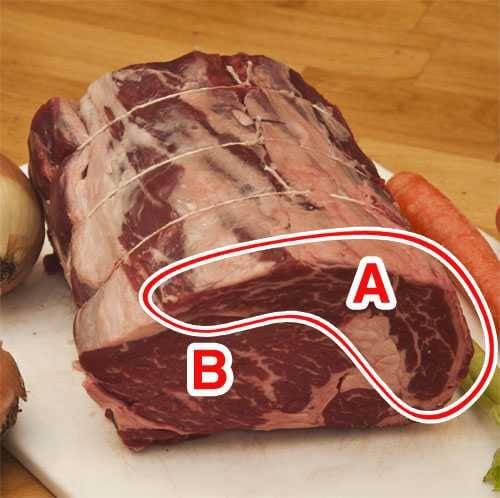
The interesting thing is, the cap, is more marbled with fat than the eye, and as beef lovers know, fat is flavor. It is so heavily marbled, it almost looks like Kobe or Wagyu beef (read more about this special meat in our article on beef grades). Look at this USDA Prime rib roast and notice the marbling in the rib cap (A).
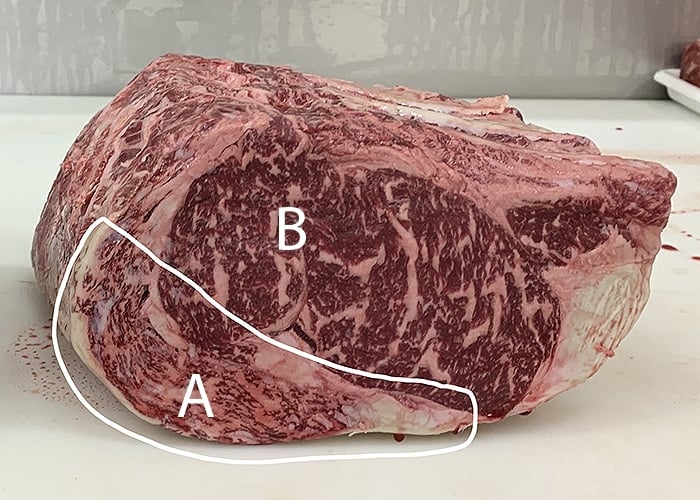
The problem is, when you cook a rib roast or ribeye steak, the exterior layers tend to get overcooked waiting for the inside to get to the proper temp. So the rib cap is almost always well done as you can see below. That is a slice from a whole prime rib roast that was smoked. As you can see, the eye (B) is perfect medium rare, but the cap (A) is well done (the pink edge is a smoke ring because this roast had been cooked on a smoker; it is not medium rare meat). This can be prevented by cooking the meat with the reverse sear method, as described in my article on cooking beef roasts. But even so, because the rib cap is on the outer rim, it does get more heat and can overcook.
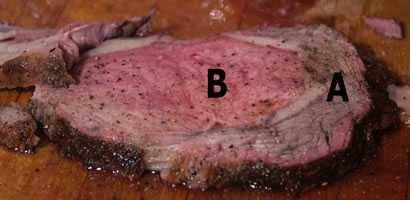
The solution to cooking rib cap perfectly? Remove it. If you remove the entire cap from a rib roast, you end up with a long triangular shaped muscle that looks a bit like a salmon fillet (below). And if you cook it separately, well, let's just say you are in for a treat.
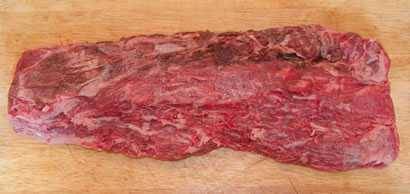
Here's a steak cut from the thick end of the rib cap.
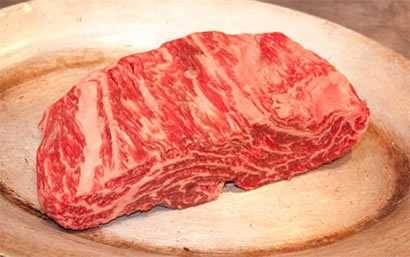
That's why when I want great beef, I often order a whole rib roast from one of the suppliers on our artisan foods page. I remove the rib rack, trim off most of the fat cap, and separate the rib cap from the ribeye. The rib rack can be smoked and makes a fine meal for two. If I want steaks, I slice the ribeye into 2-inch thick hunks perfect for reverse searing. And the rib cap, which is thicker on one end than the other (like a salmon fillet) can be quickly seared and served. To get a better steak, you'll have to travel to Kobe prefecture in Japan. Check out this video of me breaking down a whole rib roast.
If I want to feed a crowd in ceremonial style, a prime rib roast with only the ribeye is perfect for the job. Here's what a beef rib roast looks like with the cap on (your typical rib roast) and with it off (just the eye of the ribeye).
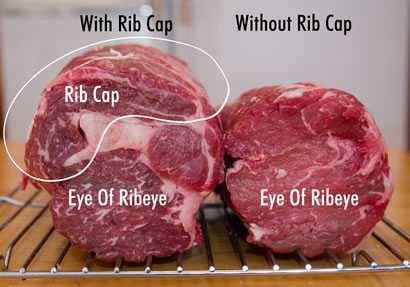
If I am lazy I order pre-cut rib cap from Allen Brothers, my favorite beef supplier.
Which end of the roast to buy?
So now the question arises. If you are buying a partial rib roast, which end do you buy? Well, the anterior of the roast, the front end near the head of the steer, is cut from between the 5th and 6th rib bone, and it is the piece that includes the thick end of the rib cap. The tapered, thin end of the rib roast comes from the posterior, towards thåe rump, and is cut between ribs 12 and 13. To reap the most benefit from the rib cap itself, buy the anterior end of the rib roast, cut specifically from up by rib 5. Then you can remove the rib cap later and cook it separately. When you remove it, keep in mind that there's a pretty thick vein of fat between the cap and the eye. Render it down and use if for frying potatoes if you like.
Source: https://amazingribs.com/tested-recipes/beef-and-bison-recipes/rib-cap-best-cut-steer/
0 Response to "Beef Ribeye Roast Large End Cut Into Steaks"
Post a Comment